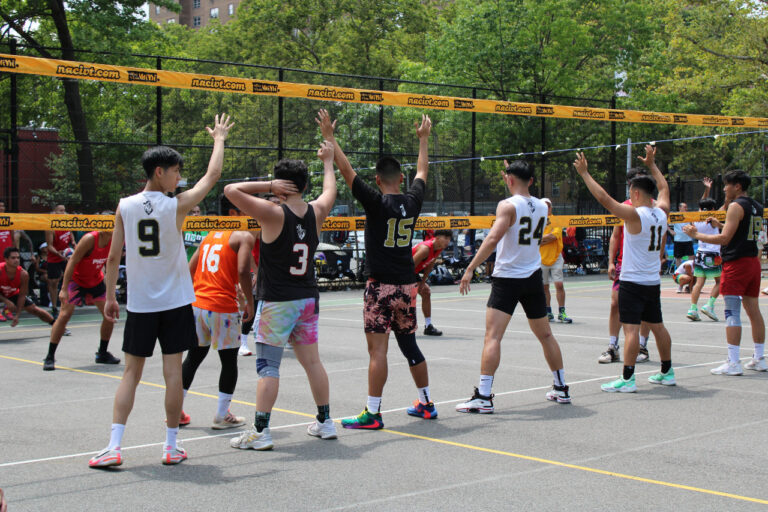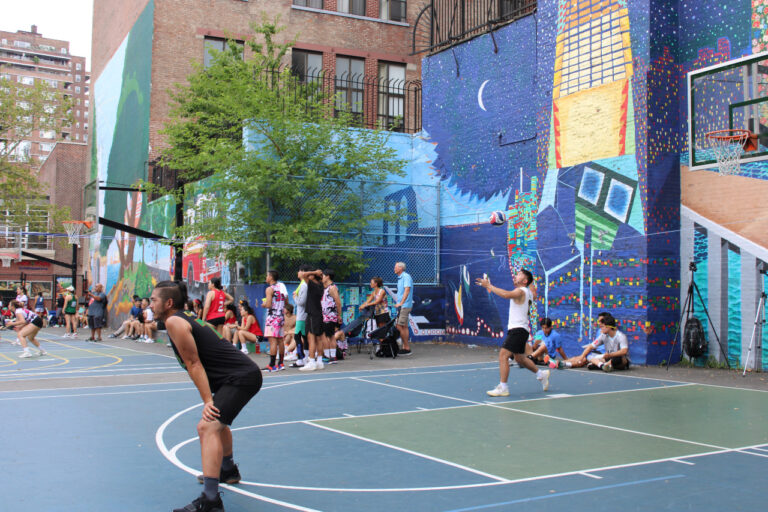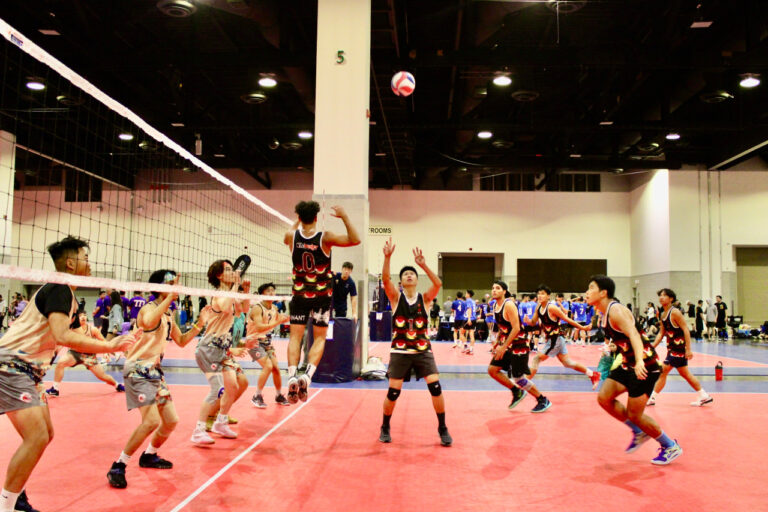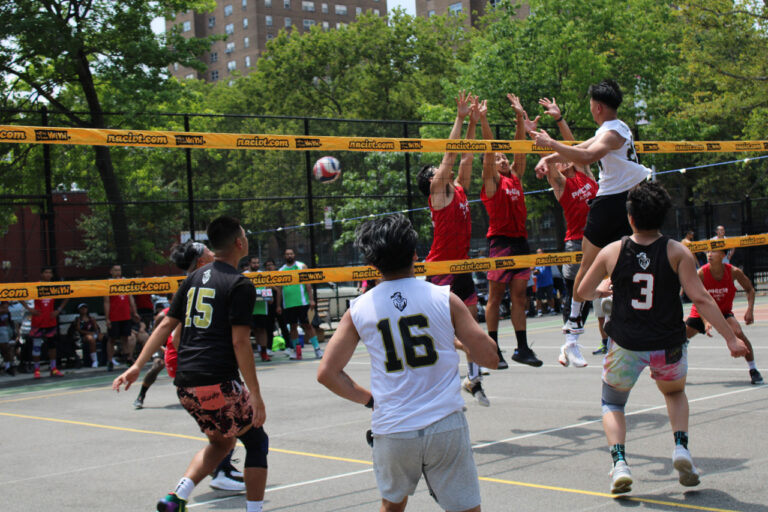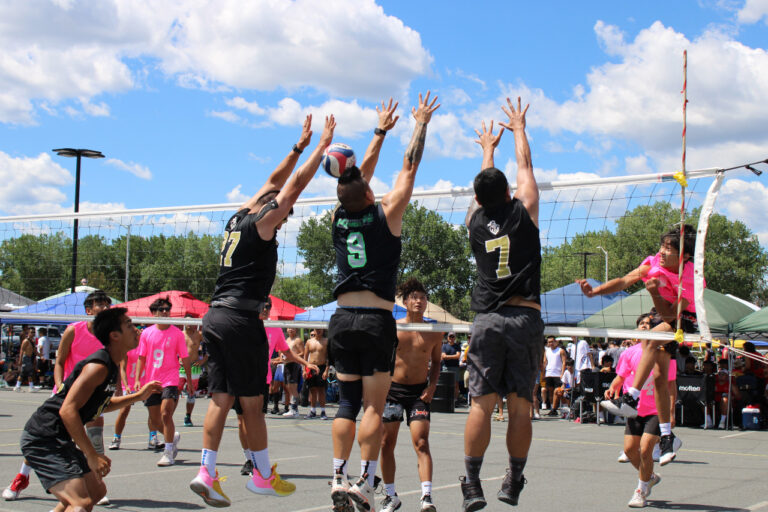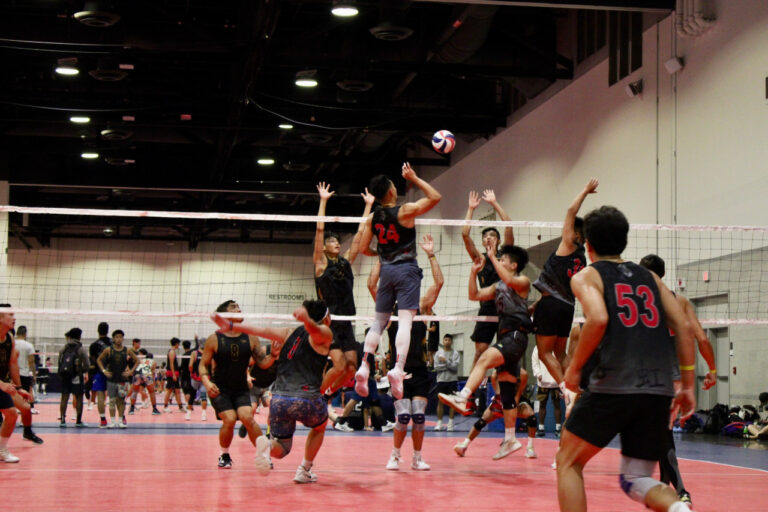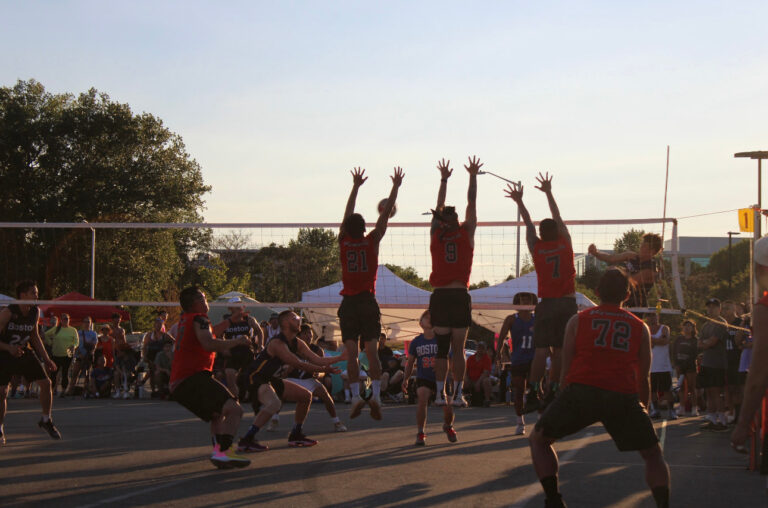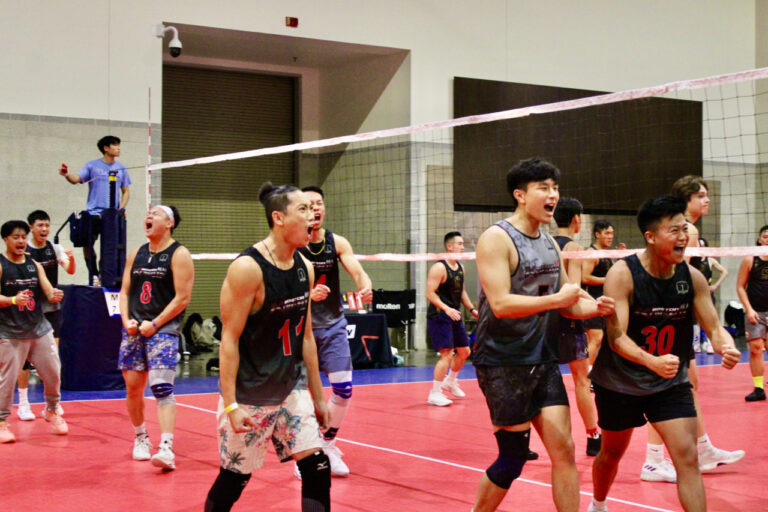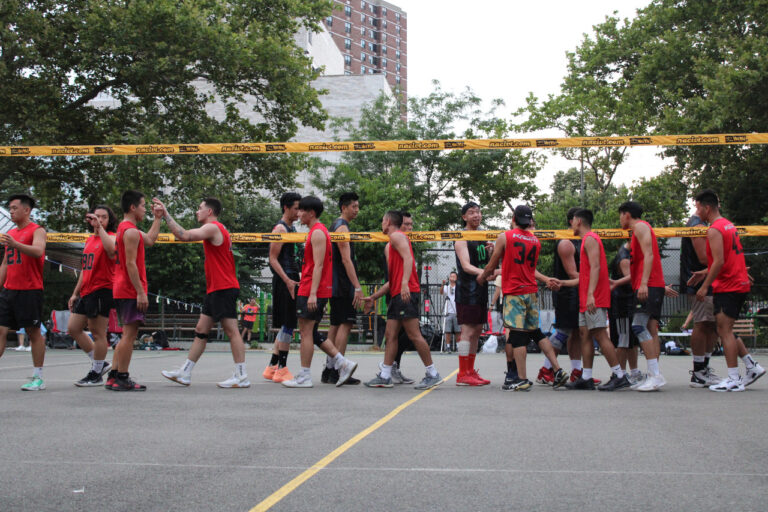Introduction to 9-Man Volleyball
Chinese 9-Man volleyball is a variation of the sport played exclusively by the Asian-American community. With a larger court, lower net, and unique rules regarding play and ethnicity, it is a faster-paced, “streetball” style of volleyball that is beloved by its community.
9-MAN VOLLEYBALL COURT
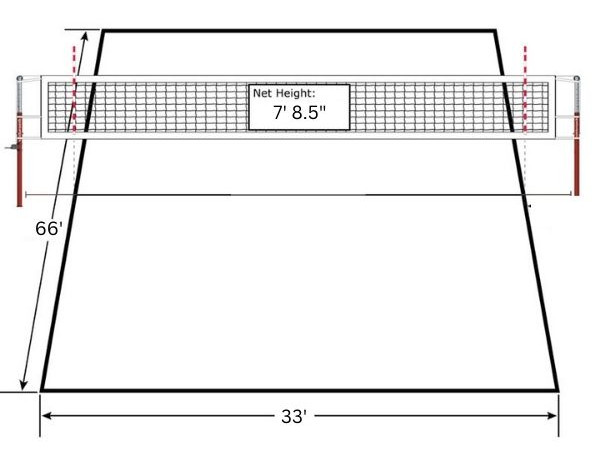
- 9man volleyball court = 33′ x 66′
- Men’s net height = 7′ 8.5″
- Two teams of nine players, separated by a net down the middle of a court
- The side lines and back line are part of the court (the ball is “in” if it hits any part of a line)
RULES OF PLAY
RALLYING
- Each play/rally starts with a serve from behind a back line
- Each team has up to three touches to return the ball across the net
- The ball must cross the net between the two antennae
- If the ball hits any part of an antenna, it is “out”
- The play ends when the ball is grounded or when a player commits an error
SCORING
- Players score points by:
- grounding the ball inside the other team’s court
- causing the other team to be unable to return the ball, or
- forcing the other team to commit an error
- After each play, one team receives a point and is the serving team for the next rally (called Rally Scoring)
- Players score points by:
MATCHES
- Matches are usually best of 3 sets
- Sets 1 & 2 are played to 21 points
- Set 3 goes to 15 points
- Teams change sides of the court when one team reaches 11 points
- Teams must win by 2 points, with games usually capped at 25 points
- Matches are usually best of 3 sets
9MAN VS. INDOOR
Ethnicity & Gender
-
- At any given time, each team must have at least six players of “100% Chinese” descent.
- The remaining three players must be of Asian descent
- The list of “approved” Asian-countries allowed to participate include Cambodia, China, Hong Kong, Indonesia, Japan, Korea, Laos, Malaysia, Mongolia, Myanmar, Philippines, Singapore, Taiwan, Thailand, and Vietnam.
- Only men are allowed to play 9-man
- At any given time, each team must have at least six players of “100% Chinese” descent.
Playing Area
-
- 9-man is traditionally played outdoors and on concrete
Contact
-
- Players may only contact the ball with their hands and arms (below the elbow)
Net Gives an Additional Touch
-
- If the ball touches the net during a volley, the team is allowed one additional touch during that volley
- The same player may touch the ball twice consecutively, if the ball contacts the net between touches
Carries Loosely Called
-
- Carries and lifts are loosely called
- Hitters may throw the ball (but cannot change the ball’s trajectory)
Blocking
-
- A block touch counts as a touch (after a block touch, the team only has two more contacts)
- Players are never allowed to break the plane of the net (called “Piking”)
Substitutions
-
- Unlimited number of substitutions can happen between rallies without needing to signal to a ref (similar to hockey subs)
Serving
-
- Only three servers are designated for each team
- At least one foot must remain on the ground during a serve
- If a serve hits the net and goes over, it is a “let” serve and the server has another chance (like tennis)
- A second “let” counts as a missed serve
Offensive & Defensive System
-
- Teams usually play with 5 or 6 players in the front row, and 3 or 4 players in the back row
- Back row players are usually in a triangle, square, or diamond shap
Rotations
-
- There are no rotations
- There is no distinction between front row and back row
POSITIONS
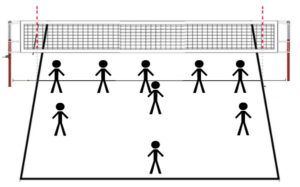
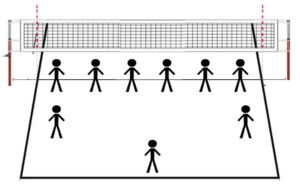
Outside
- Similar to an indoor OH
31
- Similar to an indoor OH hitting a 31
2-Ball
- Similar to an indoor middle hitting a 2
Fast Ball
- Similar to an indoor middle hitting a 1
Setter
- Similar to an indoor setter
Back 1
- Similar to an indoor right side hitting a back 1
Right Side
- Similar to an indoor RS
Middle-Middle
- Primary defender in the middle of the court
Left/Right Wing
- Similar to indoor defender playing left back/right back
Middle Back
- Similar to indoor defender playing middle back
COMMON ERRORS
Body
- A player contacts the ball with a part of their body besides their hands and arms (below the elbow)
Pike
- A player breaks the plane of the net (usually on a block)
Jump Serve
- A player has both feet in the air when they contact the ball to serve
Carry/Throw
- A player carries the ball and changes the direction (usually on fastballs)
Double Contact
- A player contacts the ball twice in a row
Four Contacts
- A team contacts the ball four times
Foot Fault
- A player steps onto the court when they contact the ball to serve
Net Violation
- A player contacts any part of the net with any part of their body or uniform
MISCELLANEOUS
- Teams bow to each other and shake hands at the net at the start and end of every match
- Similar to “street ball” in the basketball community, rules and looser, and yelling at the ref is allowed
- It is illegal to block or attack a serve in front of the 10′ line
- First official tournament between Boston and Providence, RI was in 1938
REFEREE SIGNALS
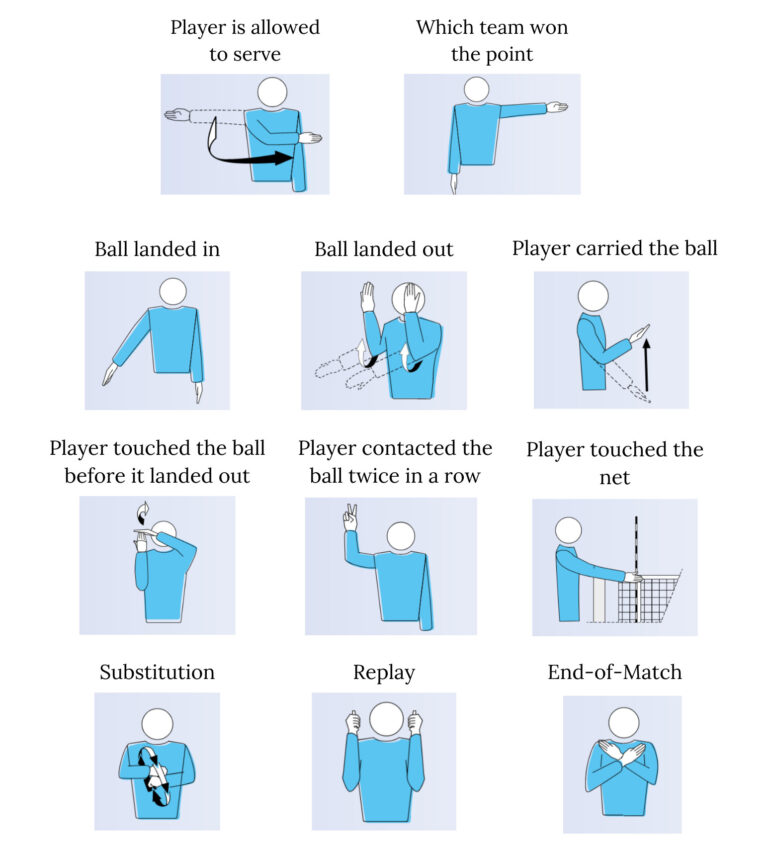
TERMINOLOGY
Ace
- A serve that results directly in a point, either when the ball hits the floor on the receiving team’s side of the court untouched, or when it is touched but unable to be kept in play by the receiving team
Kill
- A successful hit that results in an immediate point, either by grounding the ball or causing the other team to make an error
Tool
- When an attacker purposefully hits the ball off the block
Dig
- Passing an attacked volleyball (hit or tip)
Float Serve
- A serve with no spin on the ball, causing it to move erratically (like a knuckleball)
Side Out
- When the serving team loses the point, causing the other team to rotate clockwise and serve to start the next point
In-System
- The first contact is controlled and close to the net
Out-of-System
- The first contact is off the net, making the angles difficult to attack the third ball
Free Ball
- A team is sending over the ball with a forearm pass, usually not aggressively
Down Ball
- A team is sending over the ball with a swing but the player staying on the ground
Joust
- When two players contact the ball above the height of the net at the same time

